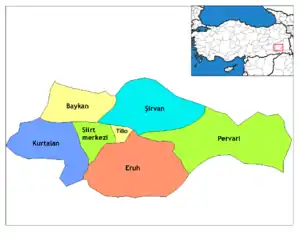Şirvan, Turkey
Şirvan (Arabic: شروان,[3] Syriac: ܫܝܪܘܢ, romanized: Sherwan,[3] Kurdish: Kufra/Şêrvan)[4] is a town and district in Siirt Province in southeastern Turkey.
Şirvan | |
|---|---|
 Şirvan | |
| Coordinates: 38°03′48″N 42°01′39″E | |
| Country | Turkey |
| Province | Siirt |
| Government | |
| • Mayor | Necat Cellek (AKP) |
| • Kaymakam | Mustafa Can |
| Area | |
| • District | 960.01 km2 (370.66 sq mi) |
| Population (2012)[2] | |
| • Urban | 4,451 |
| • District | 23,868 |
| • District density | 25/km2 (64/sq mi) |
| Post code | 56760 |
| Website | www.sirvan.bel.tr |
History
Şirvan is attested in the 13th century by Yaqut al-Hamawi in Mu'jam al-Buldan.[3] Under the Ottoman Empire, Şirvan was a kaza (district) of the sanjak of Siirt in the Bitlis Vilayet,[5] and the village of Küfre ("village" in Syriac, today called Şirvan) served as its administrative centre.[6][7] The district of Şirvan was largely inhabited by Muslim Kurds, but was also home to a number of Christian Assyrians and Armenians, who constituted roughly 20% of the total population of the district.[5] Of the total 200-odd settlements in the district, 28 were Christian, most of which were predominantly inhabited by Syriac Orthodox Assyrians, and some were populated by both Christians and Muslims.[5]
As a consequence of the removal of local Kurdish overlords as part of the Ottoman policy of centralisation in the 1830s and 1840s,[5] rural areas in the district were made vulnerable to oppression and exploitation by Kurdish tribes.[6] Christians were also the victim of religious persecution, and led many to emigrate, as well as a small number of Kurds due to economic hardship, and resulted in a gradual process of Kurdification of the district.[8]
By 1895, Küfre was populated by Assyrians and Kurds, with some Armenian families.[9] In the same year, amidst the Hamidian massacres, the village was attacked by Kurdish nomads of the Mahometan and Strugan tribes, allegedly with the permission of the acting kaymakam (district governor), Fatha Bey.[9] It was reported that all Christian houses were looted, and 25 Assyrians and Armenians were killed.[9] As well as this, almost every Christian village in the district was attacked in October–November 1895.[10] James Henry Monahan, British vice-consul of Bitlis, reported that 179 Christians (151 men and 18 women) were killed, however it is suggested that this figure may under-represent the total figure.[11]
In order to avoid future attacks, almost all Assyrians and Armenians ostensibly converted to Islam on the suggestion of sedentary Kurds.[12] The large majority of converts privately reconverted to Christianity within several years after the massacres of 1895, and only three converted villages in the district remained Muslim when visited by Monahan.[12] Oppression of Christians worsened considerably in the aftermath of the massacres, thereby increasing Christian emigration; of 22 villages in the district, over half of the population left.[13] Despite this, a number of crypto-Christian villages have endured into the 21st century.[14]
See also
References
- "Area of regions (including lakes), km²". Regional Statistics Database. Turkish Statistical Institute. 2002. Retrieved 2013-03-05.
- "Population of province/district centers and towns/villages by districts - 2012". Address Based Population Registration System (ABPRS) Database. Turkish Statistical Institute. Retrieved 2013-02-27.
- Carlson, Thomas A. (30 June 2014). "Širwān". The Syriac Gazetteer. Retrieved 16 September 2020.
- Adem Avcıkıran (2009). Kürtçe Anamnez Anamneza bi Kurmancî (PDF) (in Turkish and Kurdish). p. 57. Retrieved 17 December 2019.
- Verheij (2017), p. 129.
- Verheij (2017), p. 133.
- "Şirvan". Index Anatolicus. Retrieved 16 September 2020.
- Verheij (2017), pp. 133-134.
- Verheij (2017), p. 137.
- Verheij (2017), p. 136.
- Verheij (2017), p. 144.
- Verheij (2017), p. 149.
- Verheij (2017), p. 151.
- Verheij (2017), pp. 150-151.
Bibliography
- Verheij, Jelle (2017). ""The year of the firman:" The 1895 massacres in Hizan and Şirvan (Bitlis vilayet)". Études arméniennes contemporaines. 10 (10): 125–159. Retrieved 16 September 2020.
| Wikimedia Commons has media related to Şirvan. |

